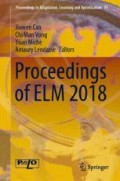Abstract
Train door is a critical subsystem in a railway system, thus fault diagnosis on train door at an early stage is essential for improving pre-emptive maintenance capability and reducing train downtime. Sensors have been installed on train door to collect data for fault detection and diagnosis by using data analysis methods. However, not all door faults are technical in nature and faults may be caused by non-technical events, such as passenger trying to stop door closing, which cannot be identified by sensor data. The normal method to exclude the man-made failures is by train captain’s inspection. This way is inefficient, unintelligent and increasing train downtime. Therefore, a condition monitoring system to realize real-time human detection is proposed in this paper. Human detection is realized by a hybrid framework - constituted by Faster R-CNN and ELM classifier, which integrates the state-of-the-art detection performance of Faster R-CNN and outstanding generalization performance and extreme learning speed of ELM classifier. Preliminary experiment results suggest the proposed system has potential to serve as an intelligent condition monitoring system.
Access this chapter
Tax calculation will be finalised at checkout
Purchases are for personal use only
References
Turgis, F., et al.: Design of a testing bench for simulating tightened-up operating conditions of trains passenger access. In: European Safety and Reliability Conference (ESREL), pp. 21–23, September 2009
Cauffriez, L., et al.: Robustness study and reliability growth based on exploratory design of experiments and statistical analysis: a case study using a train door test bench. Int. J. Adv. Manuf. Technol. 66(1–4), 27–44 (2012)
Redmon, J., Farhadi, A.: YOLOv3: an incremental improvement. arXiv preprint arXiv:1804.02767 (2018)
Ren, S., et al.: Faster R-CNN: towards real-time object detection with region proposal networks. In: Advances in Neural Information Processing Systems (2015)
Dai, J., et al.: R-FCN: Object detection via region-based fully convolutional networks. In: Advances in Neural Information Processing Systems (2016)
Szegedy, C., et al.: Scalable, high-quality object detection. arXiv preprint arXiv:1412.1441 (2014)
Liu, W., et al.: SSD: single shot multibox detector. In: European Conference on Computer Vision. Springer, Cham (2016)
Everingham, M., et al.: The Pascal visual object classes (VOC) challenge. Int. J. Comput. Vis. 88(2), 303–338 (2010)
Lin, T.-Y., et al.: Microsoft COCO: common objects in context. In: European Conference on Computer Vision. Springer, Cham (2014)
Huang, G.-B., Zhu, Q.-Y., Siew, C.-K.: Extreme learning machine: theory and applications. Neurocomputing 70(1-3), 489–501 (2006)
Huang, G.-B., et al.: Extreme learning machine for regression and multiclass classification. IEEE Trans. Syst. Man Cybern. Part B (Cybern.) 42(2), 513–529 (2012)
Huang, G.-B., Zhu, Q.-Y., Siew, C.-K.: Extreme learning machine: a new learning scheme of feedforward neural networks. In: Proceedings of 2004 IEEE International Joint Conference on Neural Networks, vol. 2. IEEE (2004)
Huang, G.-B., Chen, L., Siew, C.K.: Universal approximation using incremental constructive feedforward networks with random hidden nodes. IEEE Trans. Neural Netw. 17(4), 879–892 (2006)
Schmidt, W.F., Kraaijveld, M.A., Duin. R.P.W.: Feedforward neural networks with random weights. In: Proceedings of 11th IAPR International Conference on Pattern Recognition, Vol. II. Conference B: Pattern Recognition Methodology and Systems. IEEE (1992)
Huang, G.-B., Babri, H.A.: Upper bounds on the number of hidden neurons in feedforward networks with arbitrary bounded nonlinear activation functions. IEEE Trans. Neural Netw. 9(1), 224–229 (1998)
He, K., et al.: Spatial pyramid pooling in deep convolutional networks for visual recognition. In: European Conference on Computer Vision. Springer, Cham (2014)
Girshick, R.: Fast R-CNN. arXiv preprint arXiv:1504.08083 (2015)
Zeiler, M.D., Fergus, R.: Visualizing and understanding convolutional networks. In: European Conference on Computer Vision. Springer, Cham (2014)
Simonyan, K., Zisserman, A.: Very deep convolutional networks for large-scale image recognition. arXiv preprint arXiv:1409.1556 (2014)
Krizhevsky, A., Sutskever, I., Hinton, G.E.: ImageNet classification with deep convolutional neural networks. In: Advances in Neural Information Processing Systems (2012)
Tang, J., et al.: Compressed-domain ship detection on spaceborne optical image using deep neural network and extreme learning machine. IEEE Trans. Geosci. Remote Sens. 53(3), 1174–1185 (2015)
Liang, N.-Y., et al.: A fast and accurate online sequential learning algorithm for feedforward networks. IEEE Trans. Neural Netw. 17(6), 1411–1423 (2006)
Acknowledgments
This research work was conducted in the SMRT-NTU Smart Urban Rail Corporate Laboratory with funding support from the National Research Foundation (NRF), SMRT and Nanyang Technological University; under the Corp Lab@University Scheme.
Author information
Authors and Affiliations
Corresponding author
Editor information
Editors and Affiliations
Rights and permissions
Copyright information
© 2020 Springer Nature Switzerland AG
About this paper
Cite this paper
Sun, X., Ling, K.V., Sin, K.K., Tay, L. (2020). Extreme Learning Machine Based Intelligent Condition Monitoring System on Train Door. In: Cao, J., Vong, C., Miche, Y., Lendasse, A. (eds) Proceedings of ELM 2018. ELM 2018. Proceedings in Adaptation, Learning and Optimization, vol 11. Springer, Cham. https://doi.org/10.1007/978-3-030-23307-5_11
Download citation
DOI: https://doi.org/10.1007/978-3-030-23307-5_11
Published:
Publisher Name: Springer, Cham
Print ISBN: 978-3-030-23306-8
Online ISBN: 978-3-030-23307-5
eBook Packages: Intelligent Technologies and RoboticsIntelligent Technologies and Robotics (R0)

